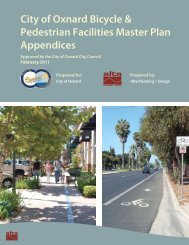View File - Development Services - City of Oxnard
View File - Development Services - City of Oxnard
View File - Development Services - City of Oxnard
Create successful ePaper yourself
Turn your PDF publications into a flip-book with our unique Google optimized e-Paper software.
WATER RESOURCES TECHNICAL REPORTadvanced water treatment process would consist <strong>of</strong> the following: (1) demineralizationusing one or more <strong>of</strong> three membrane processes (reverse osmosis (RO), nan<strong>of</strong>iltration (NF),or electrodialysis reversal (EDR) and (2) disinfection using ultraviolet light and chlorine orchloramine.The AWTF would produce recycled water for irrigation for approximately 9 months peryear and recycled water for groundwater injection approximately 3 months per year. Theadvanced water treatment element <strong>of</strong> the GREAT Program would meet agriculturalcustomer acceptance and Department <strong>of</strong> Health <strong>Services</strong> (DHS) groundwater rechargecriteria.Advanced Water TreatmentIf AWTF Option 1 is implemented, a new east-west pipeline would be required to conveytertiary effluent from the TTF to the AWTF. Approximately 500 linear feet <strong>of</strong> 30-inch pipeline(advanced treatment feed water pipeline) would convey tertiary effluent to the AWTF foradvanced water treatment. If AWTF Option 2 is implemented, only miscellaneous yardpiping would be required within the facility footprint. The advanced treatment feed waterpipeline is shown in Figure 4-2.The primary use for recycled water from the AWTF would be agricultural irrigation in thePleasant Valley area. However, irrigation demands vary seasonally, with winter monthdemands substantially lower than demands during other periods <strong>of</strong> the year. Duringperiods when demands are low (approximately 3 months each year), it would be necessaryto reduce recycled water output or develop another use for the recycled water. Since thePleasant Valley area and southern <strong>Oxnard</strong> Plain are subject to the effects <strong>of</strong> overdraft,including seawater intrusion, consideration has been given to the use <strong>of</strong> recycled water forgroundwater injection. Groundwater injection is discussed further in Section 4.3.4, AquiferStorage and Recovery.Blending Station (Blending Option 1). Prior to groundwater injection, recycled waterproduced by the GREAT Program must comply with draft DHS groundwater rechargeregulations. DHS has recently developed draft regulations dated July 21, 2003 that comprisethe most current regulation <strong>of</strong> recharge <strong>of</strong> groundwater with recycled water. These draftregulations, once finalized, are planned to supercede the 1978 DHS regulations. The GREATProgram would be in compliance with the current regulations and the draft regulations,once finalized. The draft DHS regulations as proposed require that (1) potable wells be nocloser than 2,000 feet from injection <strong>of</strong> reclaimed water, (2) potable wells recover no morethan 50 percent reclaimed water, and (3) reclaimed water remain in the aquifer a minimum<strong>of</strong> 12 months before being recovered by a potable well (DHS, 2003). To meet therequirements <strong>of</strong> the regulations, it is assumed that a 50/50 mixture <strong>of</strong> recycled water andhigher quality potable water would be injected into the groundwater aquifer at the pilotASR injection well. Blending <strong>of</strong> potable and recycled water for groundwater injection couldbe accomplished in two ways. Blending Option 1 is described in detail below. BlendingOption 2 is discussed in Section 4.3.4, Aquifer Storage and Recovery.Blending Option 1 would include construction <strong>of</strong> a blending station at the AWTF site.Blending would occur in aboveground piping at the AWTF using potable water from theexisting O-H pipeline located adjacent to the AWTF (an 18-inch pipeline that currentlyW112003002SCO LW1458.DOC/ 033390002 53
















